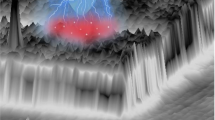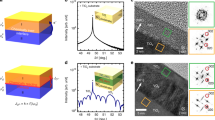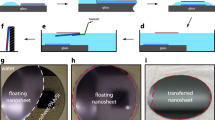Abstract
Manipulating the insulator–metal transition in strongly correlated materials has attracted a broad range of research activity due to its promising applications in, for example, memories, electrochromic windows and optical modulators1,2. Electric-field-controlled hydrogenation using ionic liquids3,4,5,6 and solid electrolytes7,8,9 is a useful strategy to obtain the insulator–metal transition with corresponding electron filling, but faces technical challenges for miniaturization due to the complicated device architecture. Here we demonstrate reversible electric-field control of nanoscale hydrogenation into VO2 with a tunable insulator–metal transition using a scanning probe. The Pt-coated probe serves as an efficient catalyst to split hydrogen molecules, while the positive-biased voltage accelerates hydrogen ions between the tip and sample surface to facilitate their incorporation, leading to non-volatile transformation from insulating VO2 into conducting HxVO2. Remarkably, a negative-biased voltage triggers dehydrogenation to restore the insulating VO2. This work demonstrates a local and reversible electric-field-controlled insulator–metal transition through hydrogen evolution and presents a versatile pathway to exploit multiple functional devices at the nanoscale.
This is a preview of subscription content, access via your institution
Access options
Access Nature and 54 other Nature Portfolio journals
Get Nature+, our best-value online-access subscription
$29.99 / 30 days
cancel any time
Subscribe to this journal
Receive 12 print issues and online access
$259.00 per year
only $21.58 per issue
Buy this article
- Purchase on Springer Link
- Instant access to full article PDF
Prices may be subject to local taxes which are calculated during checkout




Similar content being viewed by others
Data availability
All data are available in the main text or the Supplementary Information. Other data relevant to this paper are available from the corresponding author upon reasonable request. Source data are provided with this paper.
References
Imada, M., Fujimori, A. & Tokura, Y. Metal-insulator transitions. Rev. Mod. Phys. 70, 1039–1263 (1998).
Zhou, Y. & Ramanathan, S. Mott memory and neuromorphic devices. Proc. IEEE 103, 1289–1310 (2015).
Ji, H., Wei, J. & Natelson, D. Modulation of the electrical properties of VO2 nanobeams using an ionic liquid as a gating medium. Nano Lett. 12, 2988–2992 (2012).
Lu, N. et al. Electric-field control of tri-state phase transformation with a selective dual-ion switch. Nature 546, 124–128 (2017).
Li, S. et al. Large transport gap modulation in graphene via electric-field-controlled reversible hydrogenation. Nat. Electron. 4, 254–260 (2021).
Altendorf, S. G. et al. Facet-independent electric-field-induced volume metallization of tungsten trioxide films. Adv. Mater. 28, 5284–5292 (2016).
Ohta, H. et al. Field-induced water electrolysis switches an oxide semiconductor from an insulator to a metal. Nat. Commun. 1, 118 (2010).
Katase, T., Endo, K., Tohei, T., Ikuhara, Y. & Ohta, H. Room-temperature-protonation-driven on-demand metal–insulator conversion of a transition metal oxide. Adv. Electron. Mater. 1, 1500063 (2015).
Chen, S. et al. Gate-controlled VO2 phase transition for high-performance smart windows. Sci. Adv. 5, eaav6815 (2019).
Lee, D. et al. Isostructural metal-insulator transition in VO2. Science 362, 1037–1040 (2018).
Liu, M. et al. Terahertz-field-induced insulator-to-metal transition in vanadium dioxide metamaterial. Nature 487, 345–348 (2012).
Jeong, J. et al. Suppression of metal-insulator transition in VO2 by electric field–induced oxygen vacancy formation. Science 339, 1402–1405 (2013).
Nakano, M. et al. Collective bulk carrier delocalization driven by electrostatic surface charge accumulation. Nature 487, 459–462 (2012).
Liu, K., Lee, S., Yang, S., Delaire, O. & Wu, J. Recent progresses on physics and applications of vanadium dioxide. Mater. Today 21, 875–896 (2018).
Leighton, C. Electrolyte-based ionic control of functional oxides. Nat. Mater. 18, 13–18 (2019).
Zhang, H.-T. et al. Reconfigurable perovskite nickelate electronics for artificial intelligence. Science 375, 533–539 (2022).
Tan, A. J. et al. Magneto-ionic control of magnetism using a solid-state proton pump. Nat. Mater. 18, 35–41 (2019).
Huang, M. et al. Voltage control of ferrimagnetic order and voltage-assisted writing of ferrimagnetic spin textures. Nat. Nanotechnol. 16, 981–988 (2021).
Kreuer, K. D. Proton-conducting oxides. Annu. Rev. Mater. Res. 33, 333–359 (2003).
Sood, A. et al. Electrochemical ion insertion from the atomic to the device scale. Nat. Rev. Mater. 6, 847–867 (2021).
Wei, J., Ji, H., Guo, W., Nevidomskyy, A. H. & Natelson, D. Hydrogen stabilization of metallic vanadium dioxide in single-crystal nanobeams. Nat. Nanotechnol. 7, 357–362 (2012).
Yoon, H. et al. Reversible phase modulation and hydrogen storage in multivalent VO2 epitaxial thin films. Nat. Mater. 15, 1113–1119 (2016).
Bonnell, D. A., Kalinin, S. V., Kholkin, A. L. & Gruverman, A. Piezoresponse force microscopy: a window into electromechanical behavior at the nanoscale. MRS Bull. 34, 648–657 (2009).
Giridharagopal, R. et al. Electrochemical strain microscopy probes morphology-induced variations in ion uptake and performance in organic electrochemical transistors. Nat. Mater. 16, 737–742 (2017).
Garcia, R., Knoll, A. W. & Riedo, E. Advanced scanning probe lithography. Nat. Nanotechnol. 9, 577–587 (2014).
Evans, D. M. et al. Conductivity control via minimally invasive anti-Frenkel defects in a functional oxide. Nat. Mater. 19, 1195–1200 (2020).
Cen, C. et al. Nanoscale control of an interfacial metal–insulator transition at room temperature. Nat. Mater. 7, 298–302 (2008).
Bi, F. et al. ‘Water-cycle’ mechanism for writing and erasing nanostructures at the LaAlO3/SrTiO3 interface. Appl. Phys. Lett. 97, 2012–2015 (2010).
Xie, Y., Bell, C., Yajima, T., Hikita, Y. & Hwang, H. Y. Charge writing at the LaAlO3/SrTiO3 surface. Nano Lett. 10, 2588–2591 (2010).
Henderson, M. The interaction of water with solid surfaces: fundamental aspects revisited. Surf. Sci. Rep. 46, 1–308 (2002).
Acknowledgements
This research was supported by the Basic Science Center Program of the National Natural Science Foundation of China (grant no. 51788104); the National Basic Research Program of China (grant nos 2021YFE0107900 and 2021YFA1400300); the National Natural Science Foundation of China (grant nos 52025024 and 51872155); the Beijing Nature Science Foundation (grant no. Z200007); and the Beijing Advanced Innovation Center for Future Chip. L.L. acknowledges support from the Postdoctoral Innovative Talent Support Program. Y.D. acknowledges support by the US Department of Energy, Office of Science, Office of Basic Science, Early Career Research Program under award no. 68278. A portion of the research was performed using the Environmental Molecular Sciences Laboratory, a US Department of Energy User Facility sponsored by the Office of Biological and Environmental Research and located at the Pacific Northwest National Laboratory under contract no. DE-AC05-76RL01830. This research used the resources of the Beijing National Center for Electron Microscopy at Tsinghua University.
Author information
Authors and Affiliations
Contributions
P.Y. and L.L. conceived the study. M.W. and Y. Wu prepared the VO2 thin films and performed the catalytic experiments. L.L. performed the SPM-based hydrogenation, transport, Raman and cAFM experiments and data analysis with help from F.Z., H.P. and S.S.; Y. Zhou., Y.D. and Z.Z. carried out the SIMS measurements. Y. Wang and Y.L. performed the synchrotron microscopic XANES measurements. N.L. and G.W. performed the X-ray diffraction measurements. Y. Zhang. carried out the transmission electron microscopy measurements. L.L. and P.Y. wrote the paper with suggestions from C.-W.N. All authors discussed the results and commented on the manuscript.
Corresponding author
Ethics declarations
Competing interests
The authors declare no competing interests.
Peer review
Peer review information
Nature Materials thanks Jeremy Levy, Chan-Ho Yang and the other, anonymous, reviewer(s) for their contribution to the peer review of this work.
Additional information
Publisher’s note Springer Nature remains neutral with regard to jurisdictional claims in published maps and institutional affiliations.
Supplementary information
Supplementary Information
Supplementary Figs. 1–14, Notes 1–5 and refs. 1–10.
Source data
Source Data Fig. 1
Statistical source data.
Source Data Fig. 2
Statistical source data.
Source Data Fig. 3
Statistical source data.
Source Data Fig. 4
Statistical source data.
Rights and permissions
Springer Nature or its licensor holds exclusive rights to this article under a publishing agreement with the author(s) or other rightsholder(s); author self-archiving of the accepted manuscript version of this article is solely governed by the terms of such publishing agreement and applicable law.
About this article
Cite this article
Li, L., Wang, M., Zhou, Y. et al. Manipulating the insulator–metal transition through tip-induced hydrogenation. Nat. Mater. 21, 1246–1251 (2022). https://doi.org/10.1038/s41563-022-01373-4
Received:
Accepted:
Published:
Issue Date:
DOI: https://doi.org/10.1038/s41563-022-01373-4
This article is cited by
-
Nanoscale multistate resistive switching in WO3 through scanning probe induced proton evolution
Nature Communications (2023)
-
Ionic liquid gating induced self-intercalation of transition metal chalcogenides
Nature Communications (2023)
-
Artificially controlled nanoscale chemical reduction in VO2 through electron beam illumination
Nature Communications (2023)



